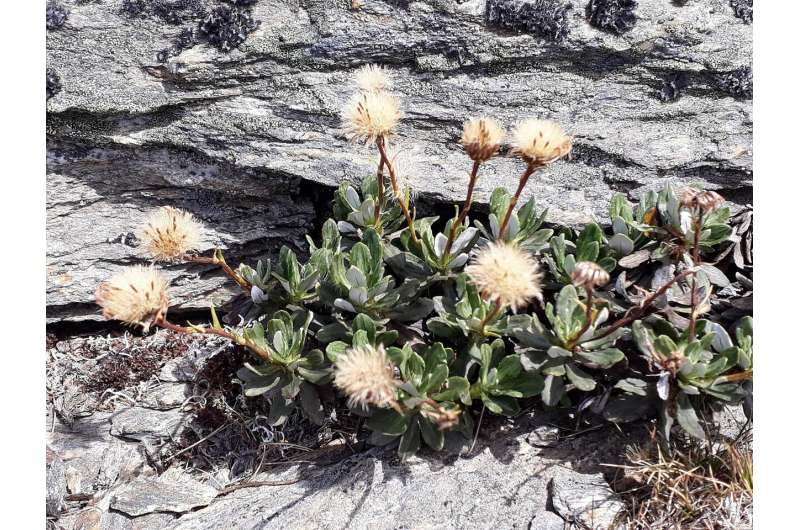How a rare plant species could hinder a needed lithium mine

Skyrocketing demand for domestically sourced lithium to meet federal goals for zero-emission technologies has developers planning for the next great mining boon in the Silver State, but a rare wildflower may stymie one proposed project.
The site of a proposed lithium mine in western Nevada's Silver Peak Range also happens to be the only known place on Earth where a rare wildflower grows in the wild. Environmentalists say the plant is on the verge of extinction, and it's being considered by the Fish and Wildlife Service for protection under the Endangered Species Act.
Tiehm's buckwheat faces multiple threats to its survival, including grazing, invasive species and the effects of climate change, but the service said the most pressing threat is posed by mineral exploration and development.
The Australian company proposing the mine, Ioneer Ltd., says it believes it can harvest the lithium without harming the plant, even if it is listed as protected under the act. But it has filed comments opposing the listing on technical grounds.
The Center for Biological Diversity first petitioned for the plant species to receive federal protection in 2019, citing the "dire threat" posed by further exploration of the site's potential as a lithium mine, "notwithstanding the broader overall threat of the mine actually being developed."
"I would be hard-pressed to see how [FWS] could justify not listing it as endangered, just based on the things the service has said," said Patrick Donnelly, Great Basin director with the Center for Biological Diversity.
The situation for the species only grew worse after a mysterious event in 2020 killed over half the plants. The Fish and Wildlife Service ultimately blamed "small mammal herbivory" by rodents.
That same year, the Center filed a complaint that the service was in violation of federal law by not acting on the initial petition. In April of 2021 the service settled with the group, agreeing to propose a listing decision, and in October 2021 it released a proposed rule that would list the species as endangered under the ESA.
Adaptation
First discovered in 1983, the plant can be found on an area of less than 10 acres administered by the Bureau of Land Management. The plant has adapted to live in boron and lithium-rich soil of the landscape, and with only roughly 40,000 existing plants in the wild, biologists have said it warrants immediate protection under the ESA. A listing would then be considered during BLM's determination on whether to permit the mine.
Demand for lithium-based batteries has been growing over the last decade. But it has been supercharged by the climate, health care and tax law signed by President Joe Biden in August, which provided tax incentives to boost the adoption of clean energy technologies, including electric vehicles. To receive the full tax credit, the law requires that critical minerals be mined within the U.S. or a nation with which it has a free trade agreement, which excludes imports from some of the world's largest producers, led by China.
The U.S. produces less than 1% of the global supply of lithium, and its entire supply comes from one facility operated by Albemarle Corp. roughly 80 miles south of the buckwheat habitat. If the mine were to open, it would immediately fulfill growing demand. In July, Ioneer signed an agreement with Ford Motor Co. to deliver 7,000 tons annually of lithium carbonate for the company's electric vehicles.
Ioneer has said throughout the listing process that it remains confident it would be able to develop the mine on the site. After the proposed listing, Ioneer Managing Director Bernard Rowe said, "We can achieve the successful coexistence of Tiehm's buckwheat and our environmentally significant project, which will supply critically needed lithium products in the U.S."
Still, the company has questioned the proposed ESA listing, arguing in public comments that the service has not fulfilled its "statutory obligation to make its proposed listing decision based upon the best available scientific data." This included challenging the results of Ioneer's own study that suggested the plant could not survive if transported to different soils, which the service used to support an assertion that the plant was a "soil specialist."
Missed deadline
The FWS blew past the one-year timeline it had to evaluate the proposed listing, drawing a notice of intent to sue from the Center for Biological Diversity on Oct. 25 to spur the issuance of a final rule. The service said it could not provide additional information on the proposed listing and that it does not comment on ongoing litigation.
While aiming to meet various domestic climate targets, including reducing emissions by as much as 52% by the end of the decade, policymakers have increasingly advocated for domestic mining as a way to reduce reliance on foreign powers and bring jobs to rural communities. But that push has raised questions about the environmental harms they may bring. Another mine proposed by Lithium Americas Corp. in northern Nevada's Thacker Pass has also drawn criticism over its potential effect on the wider ecosystem.
However, Donnelly said that ultimately there is no choice between lithium and Tiehm's buckwheat.
"There's sometimes this narrative put forward that 'Well, is Joe Biden going to choose lithium, or is he going to choose endangered species here?'" said Donnelly. "And we would argue the Endangered Species Act does not allow you to make that choice. The Endangered Species Act makes the choice for us. It is the policy of this country: We don't let species go extinct."
©2022 CQ-Roll Call, Inc., All Rights Reserved.
Distributed by Tribune Content Agency, LLC.



















